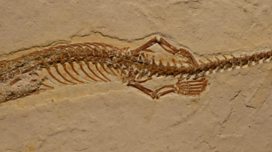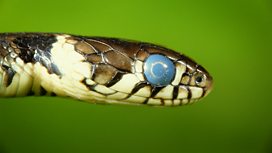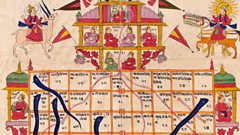Snakes
Brett Westwood explores the role snakes play in religion, art and literature. Love them or hate them they have shaped our society from earliest times.
In much of the Christian West snakes don't get a good press, they are considered sly, even evil creatures that tempted Eve causing the downfall for all humanity - quite a burden to bear. The Bible is full of less than flattering references to snakes. Many people fear snakes and kill them on sight. Yet the image of a snake wrapped around a stick is the symbol of medicine. Our complex relationship with snakes means they are amongst the most persecuted creatures on earth. There is no denying that people have in inbuilt fear of snakes as psychological experiments show. DH Lawrence's poem The Snake encapsulates our contradictory relationship with serpents. He is mesmerised by the majesty of the snake, and honoured that it chose to be near him. After scaring the snake away he regrets his mean and petty action: "I despised myself and the voices of my accursed human education." Snakes are wound intricately throughout our beliefs, art and literature.
Last on
![]()
From cannibalism to egg swallowing - 11 facts about snakes.
![]()
The World According to Snake
A Natural Histories comedy performed by David Schneider.
![]()
Four-legged snake
A fossil found in Brazil is the first four-legged snake that scientists have seen.
![]()
Grass Snakes
Lionel Kelleway tries to get close to the grass snake, Britain's largest native snake.
![]()
Howard Stableford finds out how the midland brown snake is getting help to cross the road.
![]()
In Our Time: The Fall
Melvyn Bragg examines the concept of original sin and its influence in Christian Europe.
Clips
-
![]()
Snakes and ladders: a morality test
Duration: 01:09
-
![]()
The World According to Snake
Duration: 01:41
-
![]()
The snake with the largest venom fangs
Duration: 01:52
Dr Ronald Jenner

In addition to being a Research Leader at the Museum, he is an Honorary Senior Lecturer at University College London. He has a PhD in systematic biology from the University of Amsterdam and a Masters in experimental zoology from Utrecht University.
Catherine Howell

She has played a key role in many of the Museum鈥檚 major exhibitions including Alice: The Wonderland of Lewis Carroll (1998). She was the curator of the hugely successful touring exhibitions Teddy Bear Story: 100 years of the teddy bear (2002) and Magic Worlds (2011).
Catherine Howell has worked at the Museum of Childhood since 1991 and is the collections specialist on the history of childhood toys and games.
Richard Kerridge

The book is about natural history, friendship, family, frogs, toads, newts, snakes, lizards, and the joys and anxieties of growing up. Richard has also published books and articles about nature writing and other kinds of wild literature. He teaches creative writing, including nature writing, at Bath Spa University, and was a founder of the UK branch of the .
Nigel Marven

Nigel now runs his own production company, Image Impact, and makes films for audiences all over the world.
Professor Gordon Orians

Among other areas, his research has focussed on behavioral ecology, such as habitat selection, mate selection and mating systems, selection of prey and foraging patches (foraging theory), and relationships between ecology and social organisation.
Dr Mark Porter

His special interest is in obstetric anaesthesia and the continual development of maternity services to improve the mother's experience.聽
In the past he has been a clinical director of his department, and the chair of the medical staff local negotiating committee.
Dr Deepak Shimkhada

As art historian, Shimkhada happily marries two disciplines. He is the author of many art historical articles published in journals such as , , , and .
Megan Yapp

While Brett landed on 'avarice' and his greed for material wealth sent him backwards on the board down the scales of a snake, Megan navigated the ladders and rolled a seven to find herself sitting in seventh heaven at the top of the board.
Broadcasts
- Tue 18 Aug 2015 11:00麻豆社 Radio 4
- Mon 24 Aug 2015 21:00麻豆社 Radio 4











